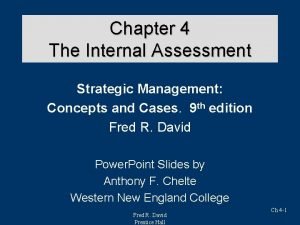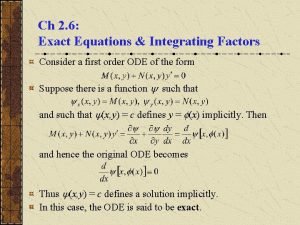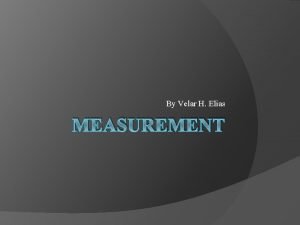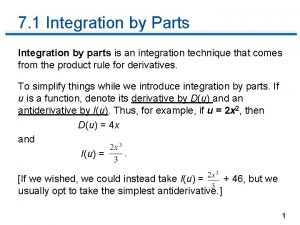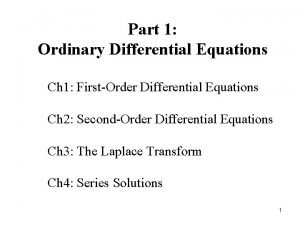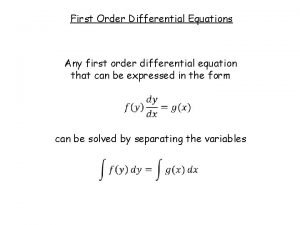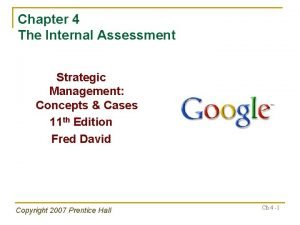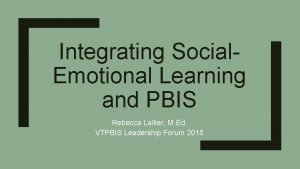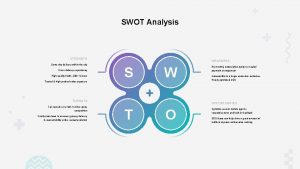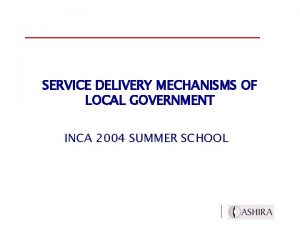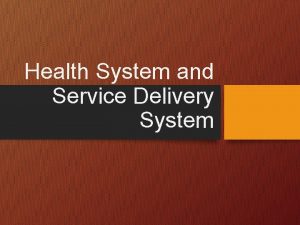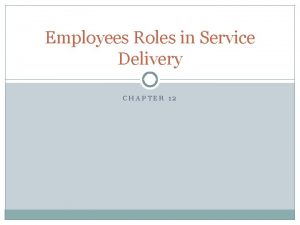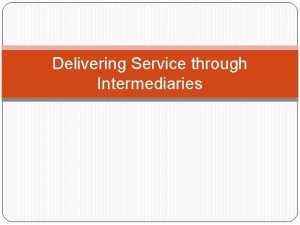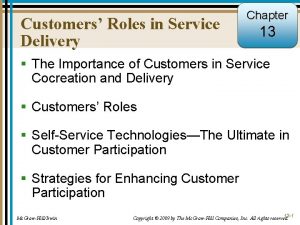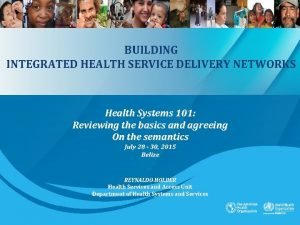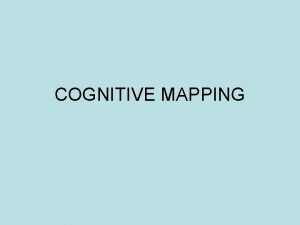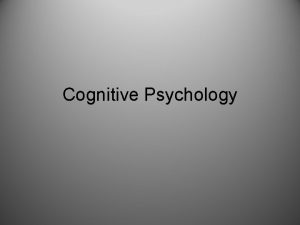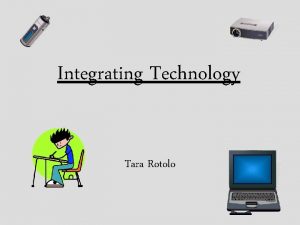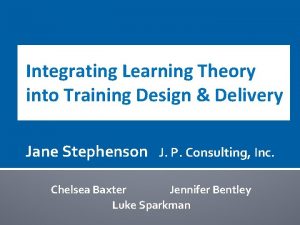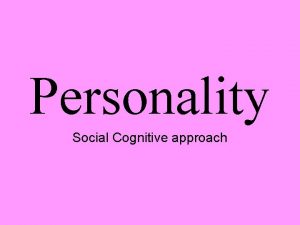Integrating DIDs into Service Delivery Understanding Cognitive Adaptive















































- Slides: 47

Integrating DIDs into Service Delivery (Understanding Cognitive & Adaptive Functioning Scores) Written and Presented by: Monica Durham, Psy. D IDD Eligibility MHMR Tarrant County * For more information about Dr. Durham’s background, please refer to the end of the presentation.

Is the purpose of a DID to: 1. Qualify a person for services or 2. Help service coordinators and providers do their jobs?

Purpose of This Training Building Relationships • • • DIDs contain the client’s cognitive profile, problem behaviors, strengths and limiting factors. It’s like knowing the person before knowing the person! Build rapport and get more information in your own assessments and work. Improving Communication • • Knowing cognitive strengths and weaknesses can help you be more effective in your communication with the person. You can help family members and providers understand how they can be more effective in communicating with people. Person Centered Planning Centering yourself inside the person’s brain, gaining insight into how they experience the world so that you can improve communication and: 1. Have PDP meetings that maximize the person’s ability to participate 2. Maximize your ability to coordinate services that will be more effective.

Training Agenda • Key Information from DIDS • Understanding Cognitive Functioning • • • Common Measures Domains of Cognitive Functioning Locations of Domains Understanding Scores Practice! • Understanding Adaptive Functioning • • Domains of Adaptive Functioning Domains of Maladaptive Functioning Understanding Scores Practice! • Conclusions • Extra Information

Key Info from DIDs (and almost all testing reports) • • • Diagnoses Cognitive Functioning Adaptive Functioning History of Testing Strengths and Limiting Factors Other history – developmental, trauma, family, etc. * All DIDs should have this information. If the DIDs you are seeing do not have this info, ask for it!

Understanding Cognitive Functioning

Common Measures of Cognitive Functioning Adults: • • • KBIT (Kaufman Brief Intelligence Scale) – 3 subtests WASI (Wechsler Abbreviated Scale of Intelligence) – 4 subtests WAIS (Wechsler Adult Intelligence Scale) – 10 subtests Children: • • • KBIT (Kaufman Brief Intelligence Scale) – 3 subtests WISC (Wechsler Intelligence Scale for Children) – 10 subtests DP-3 (Developmental Profile) – good for nonverbal kids Spanish Speakers: • • Bateria III Woodcock-Munoz – 10 subtests Bateria III Brief Intellectual Ability (BIA) Test – 3 subtests

Domains of Cognitive Functioning 1. Verbal Skills – knowledge and verbal reasoning 2. Spatial Skills – visual spatial, nonverbal reasoning 3. Fluid Reasoning – ability think logically and solve problems in novel situations, independent of previously acquired knowledge 4. Working Memory – ability to remember and manipulate recently learned information 5. Processing Speed – speed of processing information 6. Executive Functioning – ability to plan, organize, switch tasks, inhibit impulses

For the Visual Learners: Prefrontal Cortex Fluid Processing Executive Processing Forehead Left Hemisphere Right Hemisphere Verbal Abilities Working Memory Visual Spatial Abilities Processing Speed Back of Head

Verbal vs. Nonverbal • Not all IQ measures will have scores for each of those six domains. • Almost all will have some index for Verbal functioning, some index for Nonverbal functioning, and an overall IQ score. • Verbal functioning = knowledge and verbal reasoning. • Nonverbal functioning = visual-spatial, perceptual reasoning. • Neither incorporates working memory, processing speed, fluid reasoning, or executive functioning.

Understanding Cognitive Functioning Scores Three ways to think about scores: 1. Standard Scores 2. Percentiles 3. Categorical Descriptions

Understanding Scores Standard Scores • • • Standard scores are statistical derivations and are the most difficult way to understand results of testing. So naturally, that’s how IQs (and the domains that comprise them) are stated. IQ scores are expressed as standard scores. On IQ assessments, the standard score has a mean of 100 and a standard deviation of 15. A score of 100 on an IQ test means the person scored at the 50 th percentile, which means they are EXACTLY AVERAGE for their age. A standard score of 85 (100 -15) indicates that the person scored one standard deviation below the mean of the normative sample. A standard score of 70 (100 -15 -15) means the person scored two standard deviations below the mean. Why do we care? This matters to us because the diagnosis of Intellectual Developmental Disorder (IDD) is based on the person scoring two standard deviations lower than the mean. Hence, an IQ of 69 is the cutoff to qualify for IDD (according to Medicaid). (The cutoff score is higher for people with Autism Spectrum Disorder or a Related Condition. ) Practical use for us is to know how close your person’s scores are to 69. For example, an IQ = 68 means much higher cognitive functioning than an IQ score = 50.

Understanding Scores Standard Scores

Understanding Scores Percentiles • • • MUCH easier to understand than standard scores. On IQ assessments, a score of 100 on an IQ test means the person scored at the 50 th percentile, which means they are EXACTLY AVERAGE for their age; they scored better than 50% of the people their age. IQ score of 85 is at the 16 th percentile, means they scored better than 16% of people their age. IQ score of 69 is at the 2 nd percentile, means they scored better than 2% of people their age. So if you see an IQ score at the 95 th percentile, what does that mean?

Understanding Scores Percentiles

Understanding Scores Categorical Descriptions • Categorical descriptions are third and easiest ways to understand scores. • All IQ measures have descriptive categories that all look more or less the same. IQ/Domain Score Descriptive Category Percentile < 69 Lower Extreme/Extremely Low < 2 nd 70 -84 Below Average/Borderline 3 rd - 14 th 85 -115 Average 15 th – 85 th 115 -130 Above Average/Superior 85 th – 96 th > 130 Upper Extreme/Very Superior > 97 th

Understanding Scores Categorical Descriptions

Confused? • Wipe your brain clean of the graphs and just think about percentiles and categories. • Just ask yourself how much below 69 is the person’s IQ score. The further below, the more impaired. • 50 th percentile means you are exactly average, better than 50% of people like you at whatever is being measured. • Our population is the Extremely Low group, 2 nd percentile or below.

Practice Sample DID Scores • • • Kaylee is a 25 -year-old female with Down Syndrome who has just been approved by DADS to receive MHMR services. You are her Service Coordinator and are about to meet with her for the first time. She was given the KBIT-2 during her DID. Her scores are: KBIT-2 (Age-Based Scores) Standard Score Percentile Descriptive Category Verbal 65 2 nd Lower Extreme Nonverbal 57 0. 2 nd Lower Extreme Composite IQ 61 0. 5 th Lower Extreme • • What do Kaylee’s Verbal versus Nonverbal scores tell you? This is a common cognitive profile of someone with Down Syndrome. People with Down Syndrome often have IQs in or near the 60’s with slightly higher verbal than nonverbal scores.

Practice Sample DID Scores • • • Bill is an 20 -year-old male with Autism Spectrum Disorder (ASD) who is moving from his mother’s house into a group home. Bill is your client. You are in charge of his transition and need to provide training with the group home staff on how to work with Bill. He was given the WASI during his DID. His scores are: WASI-II (Age-Based Scores) Standard Score Percentile Descriptive Category Verbal Comprehension Index (VCI) 60 0. 4 th Extremely Low Perceptual Reasoning Index (PRI) 81 10 th Low Average Full Scale IQ 66 1 st Extremely Low • • What do Bill’s verbal versus nonverbal scores tell you? How will that impact your work with him and how you train the group home staff? This is a common cognitive profile of someone with Autism Spectrum Disorder (ASD). People with ASD often have higher nonverbal scores than verbal scores.

Practice Sample DID Scores • • Megan is a 14 -year-old girl who has been diagnosed with ASD. You are her service coordinator and you are trying to help her caregivers understand why she gets so upset at times and why talking to her when she is upset only causes her to escalate. WISC-V (Age-Based Scores) Standard Score Percentile Descriptive Category Verbal Comprehension Index (VCI) 70 2 nd Borderline Visual Spatial Index (VSI) 92 30 th Average Fluid Reasoning Index (FRI) 94 34 th Average Working Memory Index (WMI) 74 4 th Borderline Processing Speed Index (PSI) 63 1 st Extremely Low Full Scale IQ 73 4 th Borderline What do these scores tell you about Megan’s learning style and communication abilities? Why wouldn’t talking when she is upset be helpful? What might be helpful for Megan when she is upset?

Verbal vs Nonverbal Scores & Person Centered Planning Question: What is the main way we communicate with people? Answer: Language! We HEAVILY rely on language to communicate with people. • • Describing our roles Scheduling appointments Providing information and resources Convincing people to take their meds Negotiating rules and boundaries Talking to people when they are upset PDP and other treatment planning meetings

What if your client has low verbal skills? • What would it be like to be sitting at the table with low verbal skills during a PDP meeting? • Need to be asking yourself: 1. 2. Will my client understand me when I ask her what she wants next year’s goals and objectives to be (receptive language skills)? And even if she does know what she wants to work on this year, will she be able to tell me (expressive language skills)?

Helping Less Verbal Clients Participate in PDP Meetings • Have a pre-conversation with the client so they know what questions will be asked and have a chance to think about the content of what they want and how to say it. • Sloooooowwww down the speed of language. • Use simpler language. • Give the person time to process their thoughts and get their words out. Remember, their processing speed is going to be near the 2 nd percentile. • Repeat yourself frequently if you have a person with low working memory. • Use visual aids if you think it would be helpful. Written questions for the person, recording minutes so the person can see the recording as it happens, use social stories to ask about goals, etc.

Helping Less Verbal Clients In General • Same rules apply. Use fewer and simpler words and talk slowly. • Allow people time to process questions and figure out how to say answers. • Check for understanding in both directions. Meaning, do you understand them and do they understand you? • Use visuals whenever possible – this is good for people with working memory issues too. Schedules, pictures, social stories, etc. • The more upset people are, the less language should be used. Coping skills should be DOING things rather than talking about things. • Explore non-talk therapies – art, music, animal, play, etc.

Understanding Adaptive Functioning

Common Adaptive Functioning Measures • • ICAP (Inventory for Client and Agency Planning) Vineland Adaptive Behavior Scales Adaptive Behavior Assessment System Scales of Independent Behavior

Three Components of ICAP 1. Adaptive Behaviors 2. Maladaptive Behaviors 3. Service Score = Adaptive Behavior Level

ICAP Domains of Adaptive Functioning 1. Motor Skills – Sitting up, standing up, walking. Fine motor coordination such as writing and opening candy bars, etc. 2. Social/Communication Skills – gestures or language, language ability (sounds, words, sentences), writing ability, ability to act appropriately in public, etc. 3. Personal Living Skills – Bathing, dressing, toileting, feeding, laundry, etc. 4. Community Living Skills – counting change, telling time, ability to work at a steady pace, time and money management.

ICAP Scores Adaptive Behavior • Each domain gets a score and an age equivalent. • Broad Independence Score – it is the aggregate score of all the adaptive domains. Like domains, it gets a score and an age equivalent. • Scores are meaningless. * • Use the age equivalents for comparative purposes. *The scores are not actually meaningless, of course. They are used in the computation of scores. They are just not intuitive to the reader.

Example Adaptive Behavior Scores ICAP Scores Adaptive Behavior Domain Score Age Equivalent Motor Skills 459 4 years, 10 months Social and Communication Skills 476 6 years, 3 months Personal Living Skills 484 8 years, 3 months Community Living Skills 478 7 years, 4 months Broad Independence Score 474 6 years, 9 months

ICAP Domains Maladaptive Behavior 1. 2. 3. 4. 5. 6. 7. 8. Hurtful to Self – scratching, picking, head banging, biting, pulling out hair, hitting, etc. Hurtful to Others – applies to people and animals – hitting, kicking, biting, etc. Destructive to Property – throwing, tearing, burning, breaking things, etc. Disruptive Behavior – arguing, complaining, picking fights, yelling, pestering, etc. Unusual or Repetitive Habits – rocking, grinding teeth, tics, eating dirt, eating too much, etc. Socially Offensive Behavior – talking loud, swearing, cursing, threatening, touching genitals, urinating, etc. Withdrawal of Inattentive Behavior – keeping away from others, appearing sad or worried, showing little interest in activities, poor concentration on tasks, etc. Uncooperative Behavior – refusing to obey, follow rules, go places, cheating, stealing, law-breaking, etc.

ICAP Scores Maladaptive Behavior • • • Domains are categorized into Internalized, Asocial, Externalized, and General scores. Each category gets a score and a descriptive category. Scores are meaningless*. Focus on how far away the scores are from 0 and the descriptive categories. Categories include “Within Normal Range, ” “Marginal Problems, ” “Moderate Problems, ” “Severe Problems. ” *The scores are not actually meaningless, of course. They are used in the computation of scores. They are just not intuitive to the reader.

Example Maladaptive Behavior Scores ICAP Scores Maladaptive Behavior Score Descriptive Category Internalized -22 Moderate Problems Asocial -24 Moderate Problems Externalized -23 Moderate Problems General -31 Serious Problems

Practice Sample DID Scores • • Remember Bill, our 20 -year-old male with ASD who is moving from his mother’s house into a group home? His IQ = 66 with much better nonverbal than verbal. ICAP Scores Adaptive Behavior • • Domain Score Age Equivalent Motor Skills 446 3 years, 10 months Social and Communication Skills 459 4 years, 1 month Personal Living Skills 487 8 years, 9 months Community Living Skills 450 4 years, 9 months Broad Independence Score 461 5 years, 3 months What do these scores tell you about Bill? How will that impact your work with him and how you train the group home staff? This is a common ICAP adaptive skills profile of someone with Autism Spectrum Disorder (ASD). People with ASD often have higher personal living scores and lower scores on the other domains.

Practice Sample DID Scores • Still Bill: ICAP Scores Maladaptive Behavior Score Descriptive Category -16 Marginal Problems Asocial 7 Within Normal Range Externalized -4 Within Normal Range General -10 Within Normal Range Internalized • • • What do these scores tell you about Bill’s maladaptive behaviors? How will that impact your work with him and how you train the group home staff? This is a common ICAP maladaptive skills profile of someone with Autism Spectrum Disorder (ASD). People with ASD often have selfharming behaviors. Just for reference, his overall ICAP Service Score = 42, ABL = II.

Practice Sample DID Scores • • Remember Kaylee, our 25 -year-old female with Down Syndrome who has just been approved for services? Her IQ = 61 with slightly better verbal than nonverbal. ICAP Scores Adaptive Behavior • • Domain Score Age Equivalent Motor Skills 464 5 years, 3 months Social and Communication Skills 500 9 years, 11 month Personal Living Skills 504 11 years, 3 months Community Living Skills 487 8 years, 3 months Broad Independence Score 489 8 years, 8 months What do these scores tell you about Kaylee? This is a common ICAP adaptive skills profile of someone with Down Syndrome. People with Down Syndrome often have higher personal living and social/communication skills.

Practice Sample DID Scores • Still Kaylee: ICAP Scores Maladaptive Behavior • • • Score Descriptive Category Internalized -2 Within Normal Range Asocial 2 Within Normal Range Externalized 3 Within Normal Range General -1 Within Normal Range What do these scores tell you about Kaylee’s maladaptive behaviors? This is a common ICAP maladaptive skills profile of someone with Down Syndrome. People with Down Syndrome often have fewer maladaptive behaviors. Just for reference, her overall ICAP Service Score = 80, ABL = I.

Conclusions/Review • Key Information from DIDS • Understanding Cognitive Functioning • • • Common Measures Domains of Cognitive Functioning Locations of Domains Understanding Scores Practice! • Understanding Adaptive Functioning • • Domains of Adaptive Functioning Domains of Maladaptive Functioning Understanding Scores Practice! • How scores from DIDS can help you: • • • Build relationships Improve communication Person centered planning

Questions or Comments?

Extra Information

Extra Information: Sub-Domains of Communication Receptive Language • • • Receptive Language – ability to comprehend information that is heard or read. Analogy – it’s like someone telling you the alphabet and instead of hearing ABCDEFGHIJ…you hear ADFH, and maybe not even in that order. Implications for behavior - Many of our people have trouble understanding what we are saying to them. It is very frustrating to not be able to understand it creates many opportunities for misunderstanding on both sides. Repeating things and having the person restate back to you their understanding of things is helpful. Patience and using multiple input modes of communication can be helpful – think nonverbal communication, use of pictures, etc. Implications for treatment - Talk therapy is likely not going to be super effective with these folks. Appropriate therapies include art therapy, sand tray therapy, play therapy, etc. Implications for PDPs • People may have trouble participating in PDP meetings. They may look inattentive. • Encourage them to ask questions and keep asking questions until they understand what is being talked about.

Extra Information Sub-Domains of Communication Expressive Language • • • Expressive Language – ability to express ideas verbally and in writing. Analogy – it’s like knowing the alphabet is ABCDEFGHIJ…but when asked what the alphabet is, only being able to say A…D…H…J, and maybe not even in the correct order. Implications for behavior - Many of our people have trouble expressing their thoughts and feelings and use behaviors to communicate instead of words. People use behaviors when they’re angry or sad, but also when they are in pain. Common causes of an increase in behaviors with our population are gastric issues (particularly constipation), dental issues, and headaches. Implications for therapy - Talk therapy is likely not going to be super effective with these folks. Appropriate therapies include art therapy, sand tray therapy, play therapy, etc. Implications for PDPs • People are likely to have trouble participating in PDP meetings. Allowing them extra time to express their thoughts, giving them questions to think about in advance of the meetings are helpful. Yes/no questions work great with this population. • Rule out medical causes for problem behaviors

How Trauma Impacts Cognitive Functioning • • • When trauma is experienced as a small child, it affects every aspect of cognitive functioning. It can literally lower a child’s IQ. . . significantly. Neglect is just as bad as abuse for children. Trauma at a young age can also cause loss of skills (speech, toileting, etc. ) that can look like an ASD. These skills can usually be regained over time and particularly with treatment of PTSD. Trauma as an older child and/or adult particularly affects executive functioning, working memory, and processing speed. PTSD is an anxiety disorder, and anxiety of all different kinds impairs the same areas of cognitive functioning as PTSD. Cognitive functioning should improve with positive response to medication and/or improvement of symptoms of anxiety.

How Mood Disorders Impact Cognitive Functioning • Depression and/or depressive episodes significantly slow down processing speed. Also impacts working memory and executive functioning. • Mania speeds up processing speed but hurts executive functioning, which in turn impacts working memory. • Processing speed, working memory, and executive functioning should improve with response to medication and/or improvement of symptoms of both mania and depression.

How Schizophrenia Impacts Cognitive Functioning • People with schizophrenia tend to have certain specific cognitive deficits, particularly in areas related to language and executive functioning. • Symptoms do not improve with medication and are fairly constant whether or not the person is experiencing active psychosis.

Biographical Info. Monica Durham, Psy. D, MBA Dr. Durham is a provisionally licensed clinical psychologist in the IDD Eligibility Department at MHMR Tarrant County. She is fully licensed in the state of Massachusetts, where she graduated from William James College with a doctorate in clinical psychology. She completed her internship at Worcester State Psychiatric Hospital and her post-doctorate at a private neuropsychological assessment practice in Westborough, MA. Areas of expertise include neuropsychological and psychological evaluation and the assessment and treatment of eating disorders, anxiety disorders including PTSD, mood disorders, and borderline personality disorder. She has experience with Dialectical Behavioral Therapy (DBT) and Cognitive Behavioral Therapy (CBT) and incorporates other types of therapies and theories into her work as well. Her primary roles at MHMR Tarrant County include assessment and consultation. Email: monica. durham@mhmrtc. org
 Quote integration methods
Quote integration methods Integrating sources into your writing
Integrating sources into your writing Cognitive and non cognitive religious language
Cognitive and non cognitive religious language What are the accenture delivery method 5 main focus areas
What are the accenture delivery method 5 main focus areas Integrating quotes mla
Integrating quotes mla Lateral ventricle anatomy
Lateral ventricle anatomy Differential equation exponential solution
Differential equation exponential solution Integrating classification and association rule mining
Integrating classification and association rule mining Microsoft dynamics ax plm
Microsoft dynamics ax plm Basic concepts on integrating technology in instruction
Basic concepts on integrating technology in instruction First order differential equation formula
First order differential equation formula Integrating marketing communication to build brand equity
Integrating marketing communication to build brand equity A firm's strengths that cannot be easily matched
A firm's strengths that cannot be easily matched Conscious marketing vs csr
Conscious marketing vs csr Non exact differential equation calculator
Non exact differential equation calculator Integrating type dvm
Integrating type dvm Integration by parts meaning
Integration by parts meaning Knapp's relational development model
Knapp's relational development model Integrating factor of differential equation
Integrating factor of differential equation Integrate quotes
Integrate quotes Separation of variables
Separation of variables First order ode
First order ode Project indicators enable a software project manager to
Project indicators enable a software project manager to Integrating quotations exercise
Integrating quotations exercise Integrating business perspectives
Integrating business perspectives Integrating science and social studies
Integrating science and social studies Integrating concepts in biology
Integrating concepts in biology Internal assessment in strategic management ppt
Internal assessment in strategic management ppt Integrating partial differential equations
Integrating partial differential equations Composite function integration
Composite function integration Integrating factor
Integrating factor Integrating qualitative and quantitative methods
Integrating qualitative and quantitative methods Integrating communications assessment and tactics
Integrating communications assessment and tactics Integrating sel and pbis
Integrating sel and pbis Integrating public health and primary care
Integrating public health and primary care Hospitality service delivery system
Hospitality service delivery system Swot analysis for delivery service
Swot analysis for delivery service Human service delivery system
Human service delivery system Service delivery mechanism
Service delivery mechanism It service delivery and support
It service delivery and support It service delivery objectives
It service delivery objectives Fire service course delivery
Fire service course delivery Employees roles in service delivery chapter 12
Employees roles in service delivery chapter 12 Effective service delivery
Effective service delivery Hurgusburgus
Hurgusburgus Customers and competitors
Customers and competitors Customers role in service delivery
Customers role in service delivery Health service delivery network
Health service delivery network












